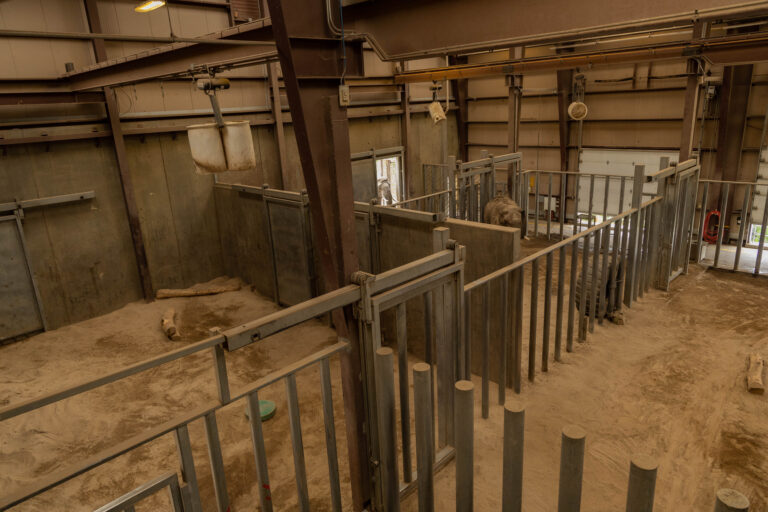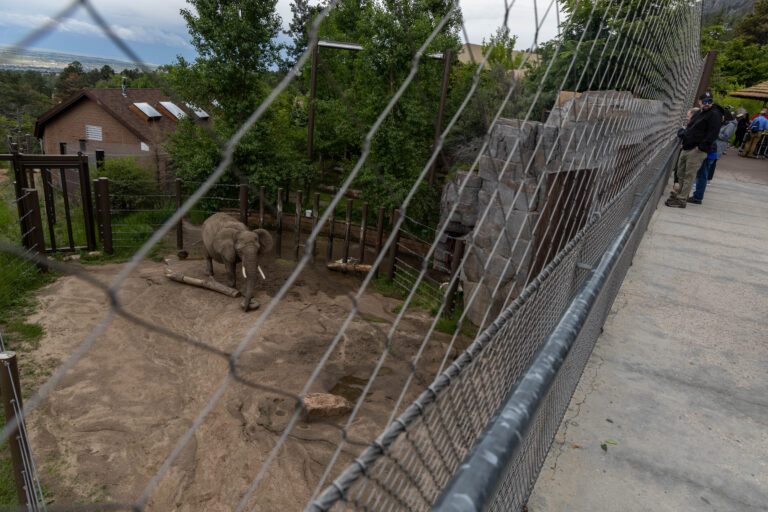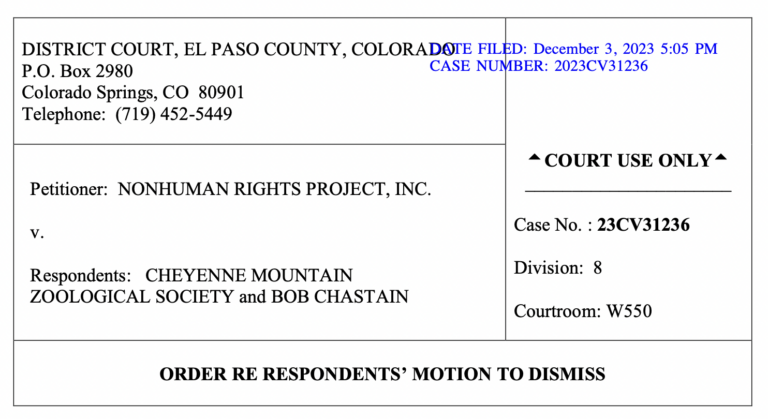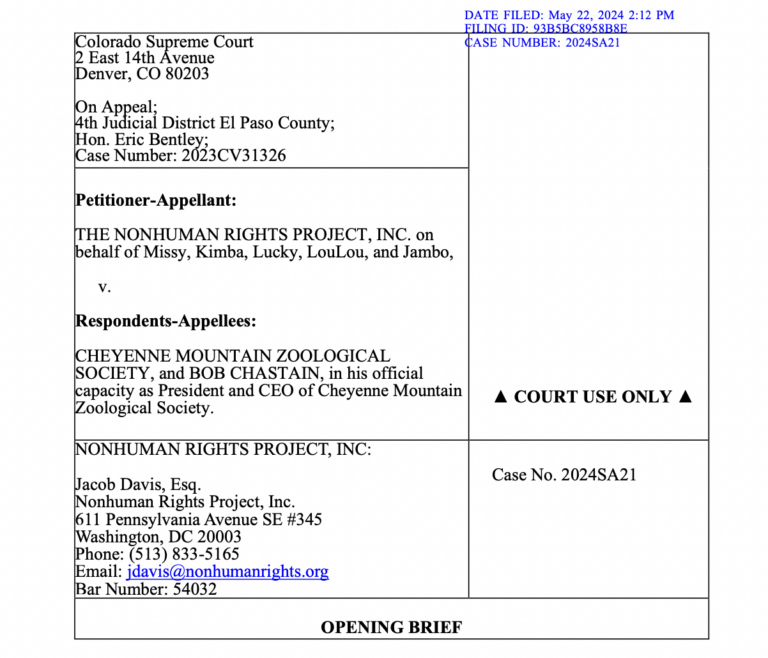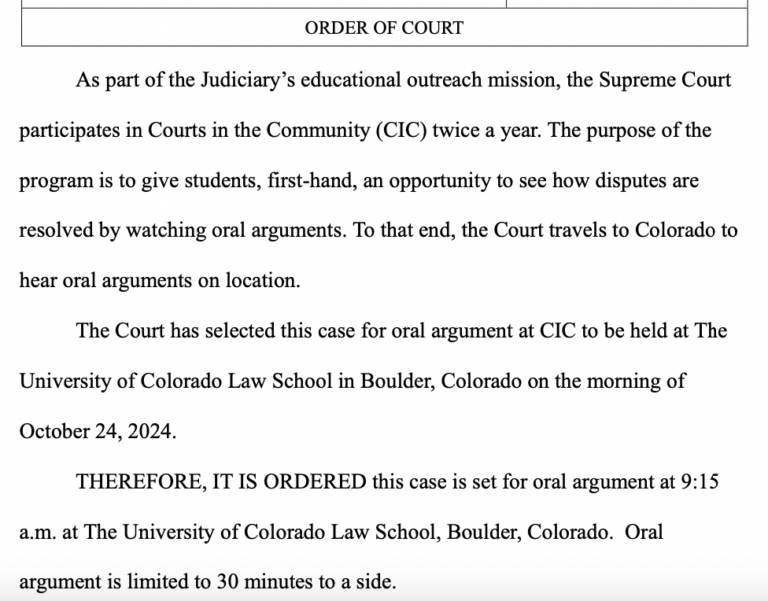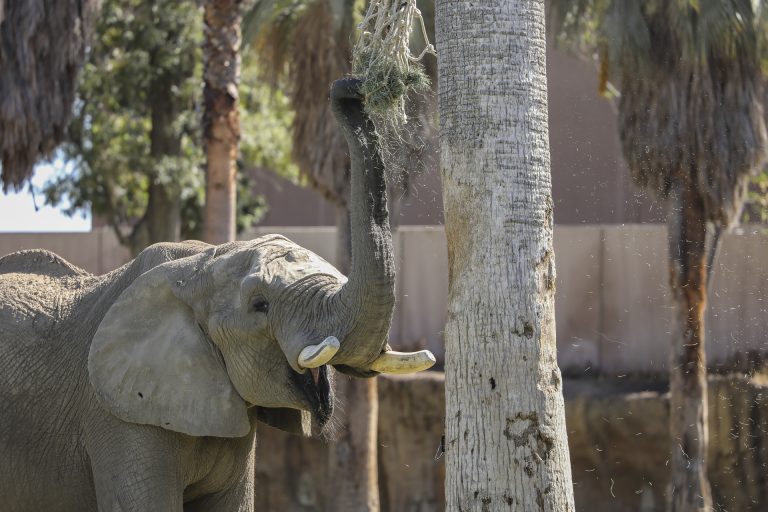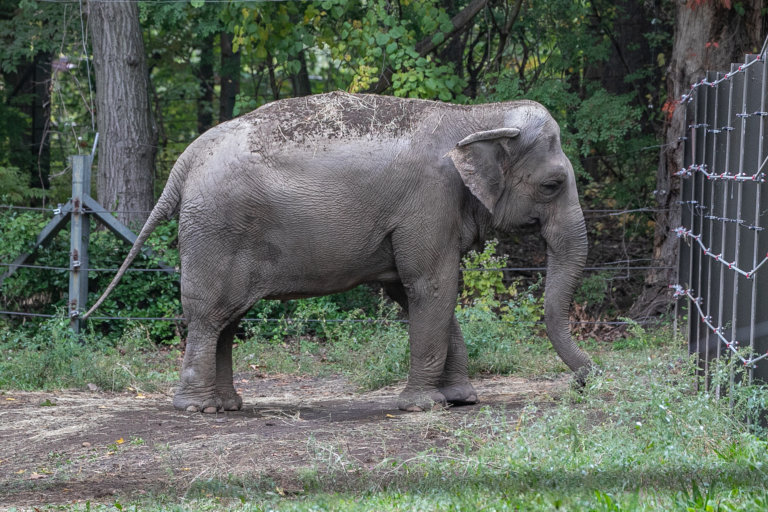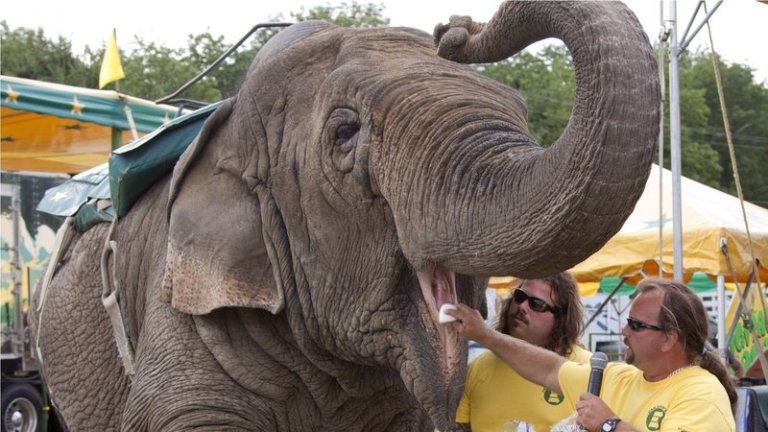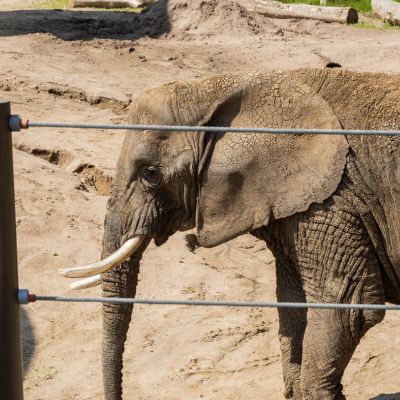

Jambo, Kimba, LouLou, Lucky, and Missy
Jambo, Kimba, LouLou, Lucky, and Missy are five wild-born female African elephants imprisoned in the Cheyenne Mountain Zoo in Colorado.
Jambo is approximately 40 years old. She was captured from her natural habitat under unknown circumstances and from an unknown location and imported to the US in 1985. For 24 years, from 1986 to 2011, Jambo–then known as Dumbo–was owned by Joe Frisco and forced to perform in a traveling circus called the Terry Frisco Elephant Act. During this time of her life, Jambo would have been controlled with a painful tool called a bullhook as are elephants still used in circuses today. The Frisco family includes several generations of elephant and exotic animal handlers and has faced numerous allegations of elephant abuse, including Joe’s brother Tim allegedly training a new employee to beat elephants. “What spectators see in the shows is simply an extension of what the elephants do on their own, just glammed up,” Joe Frisco once told a reporter.
In 2010, Jambo killed a groomer between the morning and evening shows at a circus event in Wilkes-Barre, PA. While there were no witnesses to what happened, the chairman of the circus told local media he believed Jambo, “in an attempt to protect [the groomer from the sparking wires, grabbed him and moved him away.” Other reports indicated Jambo was startled and possibly shocked by the wires and subsequently stomped the groomer. Elephant cognition and behavior expert Dr. Joyce Poole and the animal advocacy organization In Defense of Animals submitted a letter to the county coroner challenging his assessment that the death was accidental, citing elephants’ intentionality not with the objective of faulting Jambo but to underscore the stresses of captivity, which can sometimes lead to fatal attacks on humans. A year later, the Terry Frisco Elephant Act transferred Jambo to the Cheyenne Mountain Zoo.
Kimba was born in 1977 in Kruger National Park in South Africa and is approximately 46 years old. Captured and imported to the US in 1980 when she was three, she spent her first year at the still operational International Animal Exchange in Michigan, which assists zoos and governments with animal acquisition and transport. From there, she was transferred to the Cheyenne Mountain Zoo along with Lucky. According to the zoo she is prone to colic.
LouLou (formerly known as Kimba Lou) is approximately 41 years old. She was captured from an unknown location in Kenya and imported to the US in 1984 via an exotic animal dealer in Lampasas, Texas called J.C. Schulz, Inc. (the Schulz family runs the still-operational Kifaru Exotic Animal Auction in Texas). The Jacksonville Zoo and Gardens purchased Lou Lou in 1984. In 2006, when she was 24 years old, she was transferred to the Lee Richardson Zoo in Garden City, Kansas as part of an Association of Zoos & Aquariums (AZA) breeding arrangement. In 2015, she was transferred to the Cheyenne Mountain Zoo along with Missy.
Lucky is approximately 43 years old. She was born in Kruger National Park in South Africa and captured and imported to the US in 1981 when she was one. Along with Kimba, she began her imprisonment in the US at the International Animal Exchange. That same year, Lucky and Kimba were transferred to the Cheyenne Mountain Zoo. She receives injections for arthritis.
Missy is approximately 54 years old. She was captured from an unknown location in Africa in 1971 when she was approximately two years old and imported to the US in 1976. She spent several months at the no-longer-operational Largo Wild Life Preserve in Largo, Maryland. She was then transferred to the Jacksonville Zoo and Gardens in Jacksonville, Florida. In 2006, when Missy was 36 years old, she was transferred to the Lee Richardson Zoo in Garden City, Kansas as part of an Association of Zoos & Aquariums (AZA) breeding arrangement. In 2015, she was transferred to the Cheyenne Mountain Zoo along with Lou Lou. She is blind in her left eye and receives injections for arthritis. She is the oldest elephant at the zoo.
About the Cheyenne Mountain Zoo elephant exhibit
The Cheyenne Mountain Zoo is a privately owned zoo located southwest of Colorado Springs, Colorado. The zoo was built on a mountainside and sits at 6,714 feet above sea level. It is surrounded by housing developments and a golf course.
The new elephant exhibit, known as the Wilgruen Elephant Center, opened in 2013 and was part of a $13.5 million renovation of the larger Encounter Africa exhibit. According to the zoo, it was ostensibly designed to provide support to aging female African elephants. It consists of three exhibit yards that comprise less than an acre and prevent the elephants from walking more than 100 yards in any direction, a two-acre “vacation yard” the elephants are allowed to use several times a month only during the summer, a metal barn divided into stalls, and a quarter-mile walking path. The exhibit yards contain several boulders embedded into the ground and an artificial waterfall. “We hope that seeing animals in an exquisite space will allow guests to make emotional connections, and that those connections will inspire them to help protect animals in the wild,” said the zoo’s CEO and president Bob Chastain of the renovation.
The zoo groups the elephants and rotates them from yard to yard based on who they get along with. “Because the six ladies arrived at different times and came from different environments and social groups, keepers divvy them into clusters that make them feel most comfortable,” writes the Colorado Springs Gazette.
The elephants appear to spend at least half of each day in the barn standing on a rubberized concrete surface. On cold days, they’re kept in the barn all day.
For health and enrichment, the zoo provides the elephants with sand piles and uses a “target stick” to prompt the elephants to contort into unnatural positions which they (and other zoos) refer to as elephant yoga and considers physical therapy. They encourage the elephants to “paint” while on display (“all six female African elephants at Cheyenne Mountain Zoo are artists”), and the zoo sells their paintings to support their operations. Members of the public can hand-feed the elephants and observe twice-daily demonstrations of training and health inspection.
Following the renovation of the exhibit, the zoo began referring to the elephants as “the Golden Girls” in reference to the famous sitcom. However, Jambo, Kimba, LouLou, Lucky, and Missy are not yet elderly compared to the natural lifespans of elephants who live freely in their natural habitats.
Stereotypic behavior indicative of stress and trauma have been observed in the elephants, including rocking, swaying, and head bobbing. On a site visit, NhRP affiant Dr. Bob Jacobs observed that the elephants ceased the stereotypic behavior only if they were being fed, were interacting with other elephants, or participating in a training session.
The most recent elephant death in the zoo was in May of 2023, when a wild-born female African elephant named Malaika was euthanized at 37 years old following years of chronic health and mobility issues including bowing in her back. For two decades she was used in the entertainment industry. There have been no elephant births at the Cheyenne Mountain Zoo.
Jake Davis
Jake is a Colorado-licensed, Montana-based staff attorney for the NhRP. He is the lead attorney for the NhRP’s Colorado litigation. Previously, Jake worked in federal court, for the US government, and in private practice. He holds a J.D. from Loyola Law School, Los Angeles, and a B.A. from Emory University in Atlanta, Georgia.
Asked why he looks forward to working on our Colorado case, Jake says: “From the moment their adult family members were likely killed in front of them and they were sold off to be put on display and put to work in circuses and zoos, these elephants’ lives have consisted of one trauma after another. We can see this today in the stereotypic behavior, indicative of brain damage and chronic stress, all the elephants have exhibited. Despite its $13.5 million renovation, the simple truth is that the Cheyenne Mountain Zoo cannot meet Jambo, Kimba, LouLou, Lucky, and Missy’s complex physical, social, and emotional needs. No zoo can.”
Who's joined us in the fight
The first litigation of its kind in Colorado, the NhRP’s petition has the support of world-renowned experts in elephant behavior and cognition. Among those who have submitted declarations (equivalent to affidavits) is Dr. Bob Jacobs, a professor of neuroscience at Colorado College who has studied the neurological harm of captivity on elephants and observed the Cheyenne Mountain Zoo elephants engaging in behavior indicative of brain damage from stress and trauma, including rocking, swaying, and head bobbing.
“These elephants deserve much better, and keeping them in captivity in this zoo is a sorry reflection on the human condition,” said Dr. Jacobs of his support for this case. “I wouldn’t want to be confined to an austere, barren environment for a week, let alone a lifetime. But that’s what these elephants must endure, leaving them vulnerable to chronic stress and chronic health problems, including deleterious effects to their very sophisticated brains.”
Donate to support the fight
Donate online
Mail a check
611 Pennsylvania Ave SE #345
Washington, DC 20003
Planned giving
Create a fundraiser
Highlights from the fight
Media coverage
A timeline of Jambo, Kimba, LouLou, Lucky, and Missy’s case
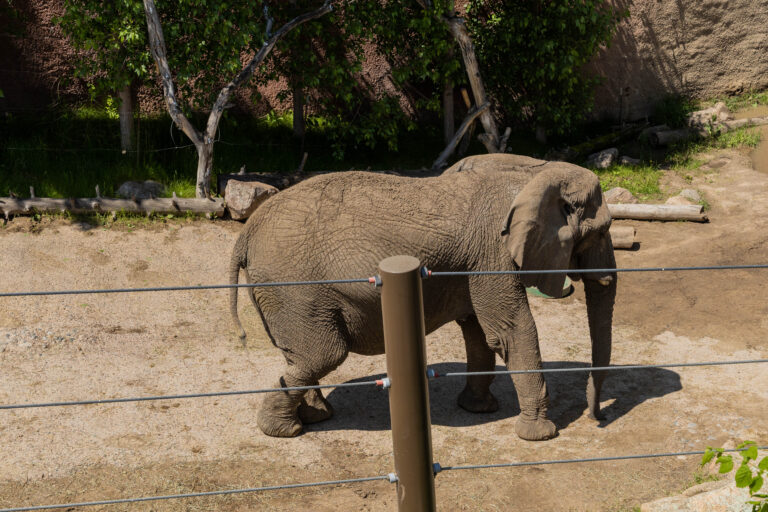
6.29.23
The NhRP files a habeas corpus petition in the 4th Judicial District (El Paso County) Court, demanding the elephants’ right to liberty and release to a sanctuary.
Elephant cognition and behavior experts Keith Lindsay, Lucy Bates, Richard W. Byrne, Bob Jacobs, Karen McComb, Cynthia Moss, and Joyce Poole submit declarations in support of the case.
6.30.23
District Court Judge Eric Bentley issues an order that requires the Cheyenne Mountain Zoo to respond in writing to our arguments.
As NhRP Staff Attorney Jake Davis writes in our statement, “Given that Judge Bentley had the option of simply denying our petition, without requiring the zoo to respond to our arguments, we are greatly encouraged by this order because it potentially brings us one step closer to freeing Jambo, Kimba, LouLou, Lucky, and Missy from their unlawful imprisonment.”
Judge Bentley also issues an order regarding a potential recusal.
7.21.23
In response to Judge Bentley’s order regarding a potential recusal, the NhRP and the Cheyenne Mountain Zoo file a joint notice, waiving disqualification.
7.24.23
The NhRP sends a letter to the Cheyenne Mountain Zoo’s attorneys, offering to settle the case if the zoo agrees to release the elephants to a sanctuary accredited by the Global Federation of Animal Sanctuaries (GFAS).
7.25.23
8.11.23
Attorneys for the Cheyenne Mountain Zoo send a letter rejecting the NhRP’s settlement offer.
8.14.23
The NhRP responds to the Cheyenne Mountain Zoo’s refusal of the NhRP’s offer to settle the case if the zoo were to release the elephants to a sanctuary accredited by the Global Federation of Animal Sanctuaries (GFAS).
8.31.23
The Cheyenne Mountain Zoo files a motion to dismiss the case and a proposed order.
10.5.23
The NhRP files our opposition to the Cheyenne Mountain Zoo’s motion to dismiss.
10.19.23
The Cheyenne Mountain Zoo’s attorneys file their reply in support of their motion to dismiss the NhRP’s case.
11.3.23
The NhRP files a motion asking the Court for permission to serve a Supplemental Pleading.
11.24.23
The Cheyenne Mountain Zoo files an opposition to the NhRP’s motion to serve a supplemental pleading.
12.1.23
The NhRP files a reply in support of our supplemental pleading motion and in opposition to the Cheyenne Mountain Zoo’s motion to strike it.
12.2.23
Judge Bentley grants the NhRP’s supplemental pleading motion. As described in the Supplemental Pleading, recent videos of LouLou and Jambo taken on October 27, 2023 show the elephants repeatedly swaying back and forth, exhibiting behavior known as stereotypies—a sign of brain damage caused by chronic stress. These videos represent clear evidence that the elephants are living a sad, miserable existence. Notably, the videos depict the same stereotypic behaviors that Dr. Bob Jacobs observed when he visited the Cheyenne Mountain Zoo over a year ago.
12.3.23
Judge Bentley dismisses the NhRP’s petition but agrees with the NhRP that the Cheyenne Mountain Zoo “deprives Missy, Kimba, Lucky, LouLou, and Jambo of the space and variety of terrain that they need to roam, exercise, and live healthy elephant lives; and that they would be better off in an accredited elephant sanctuary. Read our statement here.
1.19.24
The NhRP files a notice of appeal, including an advisory listing of issues to be raised on appeal. The deadline for the filing of our appellate brief will be set after the trial court files a record on appeal.
5.22.24
The NhRP files an opening brief in the Colorado Supreme Court, urging it to reverse District Court Judge Eric Bentley’s ruling. The NhRP’s appeal marks the first time Colorado’s highest court will be in a position to rule on arguments concerning a nonhuman animal’s right to liberty. In addition to requesting that the Colorado Supreme Court reverse the District Court’s ruling, the NhRP is asking for the case to be remanded to the District Court, with instructions to hold a hearing on the merits of the NhRP’s petition. The Cheyenne Mountain Zoo will have the opportunity to respond to the NhRP’s opening brief, and the NhRP will request oral argument.
The NhRP also filed a motion to exceed the word limit. If the Court does not grant this request, the NhRP will file a shorter brief.
Read our press release here.
5.29.24
Shannon Minter (Legal Director of the National Center for Lesbian Rights) and Evan Wolfson (founder of the Freedom to Marry movement). Read their brief here.
Maneesha Deckha (Professor and Lansdowne Chair in Law at the University of Victoria Faculty of Law in Victoria, British Columbia). Read her brief here.
Edwin Cameron (former Justice of the Constitutional Court of South Africa). Read his brief here.
A group of nine philosophers with expertise in animal ethics, political theory, the philosophy of animal cognition and behavior, and the philosophy of biology. Read their brief here.
A group of 24 UK-based legal academics, solicitors, and barristers who variously teach, research, advise, and litigate in the field of animal law. Read their brief here.
5.30.24
The NhRP files a shorter opening brief in response to the Court’s dismissal of the NhRP’s motion to exceed the word limit.
6.26.24
The Cheyenne Mountain Zoo files a reply to the NhRP’s opening brief. The Association of Zoos & Aquariums (AZA) files an amicus brief in support of CMZ.
7.17.24
The NhRP files a brief that responds to the arguments in the zoo’s reply brief. As in our opening brief, we argue that Missy, Kimba, Lucky, LouLou, and Jambo must not be denied the opportunity to challenge their unjust and abjectly cruel confinement through the time-honored writ of habeas corpus simply because they’re not human. We’re now waiting for the Colorado Supreme Court to set a date for oral argument on these briefs.
7.24.24
The Colorado Supreme Court issues an order indicating it will hear arguments in this case on Oct. 24th, thus becoming the second US state high court in the US to hear arguments in support of animal rights, specifically elephants’ right to liberty (Happy’s case in New York was the first).
The hearing–the first of its kind in Colorado and the region–will take place at the University of Colorado Law School in Boulder as part of the the Courts of Community program, which gives students the opportunity to observe oral arguments.
10.24.24
The Nonhuman Rights Project argues for the elephants’ right to liberty before the Colorado Supreme Court. Read our press release here.
1.21.25
2.5.25
The NhRP files a petition for rehearing urging the Colorado Supreme Court to reconsider its wrong and dangerous opinion. The petition for rehearing argues that the Colorado Supreme Court incorrectly deferred to the legislature to limit the scope of common law habeas corpus, which is a critical judicial safeguard of civil liberties dating back to the Magna Carta.
Christopher Berry, Executive Director of the NhRP: “Anyone who cares about civil liberties should be concerned by this opinion no matter their view about elephant captivity in zoos. The Colorado Supreme Court should have sent this case back to the lower court to squarely address whether the elephants’ confinement is justified, rather than permitting legislative erosion of the safeguards of habeas corpus.” Read our press release here.
The science
